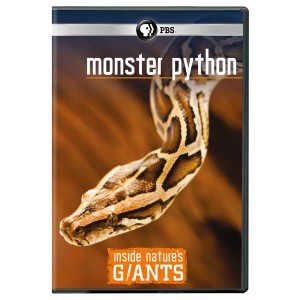‘Monster Python’ slithers its way onto DVD

Inside Nature’s Giants, the successful PBS program, doesn’t figuratively go “inside” the monster-like animals of our planet. It literally goes “inside,” with a scalpel in one hand and rolling TV cameras in the other. For the program’s Monster Python special, researchers head down to the Florida Everglades to catch, dissect and study Burmese pythons. The footage they are able to capture is quite unsettling and endlessly interesting.
Veterinary scientist Mark Evans and comparative anatomist Joy Reidenberg know that Florida has a problem with its pesky pythons. The species was likely introduced to the Everglades after a few pets were let loose in the wilds. But there’s still a mysterious aura around the snake’s presence in Florida. After all, it’s a native of Southeast Asia, not Disney World.
It doesn’t take long for the team to find a few samples in the overgrown grass beneath a pulsating sun. In their quest to capture an autopsy candidate, the TV cameras capture some amazing footage. Too often, reality series feel staged and calculated. Inside Nature’s Giants, on the other hand, feels spontaneous and real. Just look at how one snake enthusiast spots a python in the grass and then proceeds to grab it by the back of its head. The presence of the snake surprises the man and the camera crew.
After a suitable sample is selected, the team then cuts into the snake to see how it operates on the inside. For some, this part will be way too gruesome to endure. Others may question why a snake needs to be killed to learn essentially what scientists already know (the PBS team took advantage of a “population cull” of Florida’s Burmese pythons). The chance to peel away the skin and scales and look into the uniqueness of these monsters is quite interesting, but a computer model could have produced similar effects. The team is able to make some new discoveries about the species, but does that make the autopsy worth it?
There can be great value to programs like Monster Python. If for no other reason, it gives viewers a better chance to learn about a misunderstood animal. One doesn’t leave the 60-minute program wanting to go hug Burmese pythons in the wild (note to readers: hugging pythons could prove deadly), but it does offer a renewed sense of appreciation for this serpent. The way it kills its food and then slowly digests it over the course of several days is a novelty of the animal kingdom. Its mouth, teeth and tongue are fascinating, and the same goes for its internal organs.
Burmese pythons may be detrimental to the Florida habitat, but they offer researchers and the casual viewer a chance to understand a species that should be slithering halfway around the world. Next time, it would be great if they could autopsy a snake that died of natural causes, rather than one caught in the wild.
By John Soltes / Publisher / John@HollywoodSoapbox.com
-
Inside Nature’s Giants: Monster Python
-
Produced and directed by Jamie Lochhead
-
Running time: 60 minutes
-
Not Rated
-
Rating:





